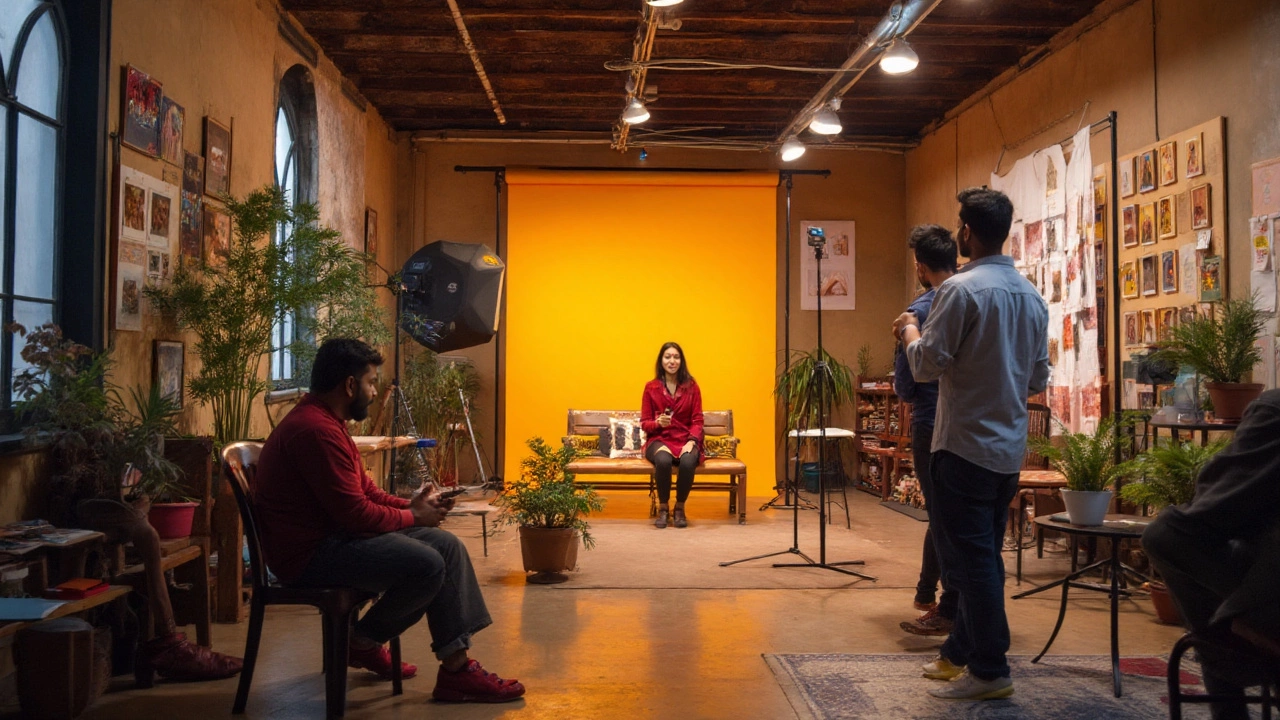How Much to Charge for Studio Time: A Photographer’s Step-by-Step Guide
 Aug, 5 2025
Aug, 5 2025
You’d be shocked how many photographers new to studio ownership almost give away their time—or charge so much that nobody books at all. Here’s what’s wild: there’s no fixed price for studio time, and what works in Mumbai could make no sense in LA. If you’re sweating over what’s fair and how much is too much, you’re not alone. There’s a lot more to it than slapping a price tag based on what the next guy’s charging. Let’s break it down and get you paid what you’re actually worth, without scaring off your best clients.
What Goes Into Setting Your Studio Time Price?
People often ask, “What’s a going rate?”—but that’s just scratching the surface. Every studio is unique. Here’s what really shapes the price tag on your walls:
- Location: A central studio in a big city can charge more than one out in the suburbs. Rent, demand, and local competition push your price up or down.
- Space and Facilities: High ceilings, natural light, seamless paper, props, and climate control all add value. A studio with blackout curtains, a makeup station, and free parking has way more pull than a basic room.
- Equipment: Are you including lights, modifiers, and backdrops? What about camera rentals, triggers, or specialty lenses? If yes, you bump up the rate—for good reason.
- Time Slots and Duration: Weekday mornings are usually less in demand than Saturday afternoons. Offer an hourly, half-day, or full-day rate. Longer bookings often mean a lower hourly price.
- Staff and Assistance: Do you (or an assistant) stick around to handle lights or sweep up? If so, you’re providing more than just a space—that’s an add-on clients expect to pay for.
- Market Rates: Scouting what other local studios offer is smart, but try to compare apples to apples. Find at least three nearby studios with similar facilities and pricing, and note what they include or charge extra for.
- Running Costs: Don’t forget boring stuff like insurance, cleaning, utilities, and minor repairs. This eats a chunk of your earnings if you set your price too low.
- Your Experience: Newer studios sometimes charge less to build up their client list. Still, if you offer a killer booking experience or extras, go higher. Established studios can rely on strong portfolios or testimonials to justify their rates.
All these things mix together to create your “minimum price”—the lowest you’d charge without losing money. Anything below that, and you’re basically paying clients to use your space. And nobody wants that. Here’s a quick look at the usual split of costs that go into a typical studio in India, according to 2024 numbers from industry groups:
| Cost Category | Percentage of Total |
|---|---|
| Rent/Mortgage | 35% |
| Utilities | 10% |
| Maintenance/Repairs | 7% |
| Insurance | 4% |
| Equipment Upkeep | 12% |
| Marketing & Admin | 8% |
| Cleaning/Sanitization | 4% |
| Profit Margin | 20% |
Notice that your profit actually comes last on this list. So, when figuring out how much to charge for studio time, put all your regular monthly costs on paper, divide by the hours you think you’ll rent out, and then tack on your target profit. That’s your starting point.
Average Rates and What They Really Mean
Studio rental pricing varies dramatically based on geography, features, and even season. Here are some ballpark numbers from 2025 pulled from Peerspace, Studiobooker, and a few big metro studios in India and the US. Spoiler: you’ll see a range.
- Basic studio (bare space, 400–600 sqft, one light kit): ₹700–₹1,500 per hour; $30–$60 per hour in US cities outside New York or LA.
- Full-service photo studio (1000+ sqft, professional equipment, amenities): ₹2,000–₹4,500 per hour; $80–$150 per hour in places like New York, London, or Sydney.
- Half-day rates (4–5 hours): Usually 30–40% off the single hourly rate. Many clients want this deal.
- Full-day rates (8–10 hours): Typically 50–60% off what you’d make if booked by the hour all day.
- Overtime charges: These can be as high as 1.5–2x your normal hourly price. Write this clearly in your policy and don’t be shy to enforce it.
Sound high? Remember, these rates aren’t profit. Out of every ₹1,000 you charge, around ₹800 is going right back into rent, bills, or fixing a wobbly stool. That’s why the world’s best studios don’t just set prices and hope—they constantly watch what gets booked and tweak things. If weekends book out fast, raise rates just for those slots. If Tuesdays are dead, offer a discount. A good booking calendar gives you the real story.
Some studios quietly negotiate, especially with clients who book many hours or plan regular shoots. But don’t lock yourself into a deal you’ll regret. Give deals for longer bookings, but don’t discount so much that you start resenting the work.

Hidden Costs and Overlooked Policies
Too many photographers forget the “tiny extras” that add up. If your price only covers rent, you’re headed for a headache. Here’s what to include (or charge for) that most people ignore:
- Cleaning fees. Even the cleanest creatives leave hairspray or food wrappers behind. Build this into your rate or charge a cleaning fee—don’t eat the cost yourself.
- Equipment wear and tear. Flashes don’t last forever. Consider a small “equipment maintenance” fee per session, or plan to raise rates slightly every year to cover repairs.
- Consumables. Gaffer tape, backdrop paper, snacks, even drinking water—they all add up. Some studios charge for things like seamless paper rolls if they get dirty or cut for floorshots.
- No-shows and late cancellations. This one stings. Always take a deposit when booking and set a clear cancellation window. Keep it strict—if folks flake, you still cover costs.
- Overtime/Extra hours. Shoots almost always overrun. List out your overtime charges and be ready to enforce them so late clients don’t eat up your day.
- Insurance/taxes. Studios must have liability insurance. The premium is a real cost, even if clients never see it. And don’t skip taxes—even a side hustle needs paperwork to avoid nasty surprises.
- Security and access. If you have a key card or building staff, there’s a cost. Some studios factor this into rates, or charge extra for after-hours access.
Small tip: spell everything out up front. Write an honest, short list of what your studio offers. Don’t bury rules in fine print; if you charge extra for anything, bring it up during booking. People are way less likely to argue if you’re transparent from day one.
If you’re not sure what hidden costs you might be missing, chat up a few other studio owners or even event space managers. People are usually friendly if you’re polite, and you’ll learn what they wish they’d done from the start. Avoiding a rookie mistake is worth any awkward phone call.
Tips That Make Pricing (and Life) Easier
Getting pricing right is about more than math. It’s also about psychology and how you position your space in the market. Here are the real-world strategies the pros use:
- Create booking packages. Offer “gold,” “silver,” and “bronze” options that include different levels of studio time, equipment, and assistance. Clients like clear choices. Example: Bronze is bare space, Silver adds gear, Gold brings lighting help or snacks.
- Limit cheap rates to slow times. Nobody wants to lose out on Saturday bookings at weekday rates. Use lower pricing just for your emptiest slots, and keep premium hours exclusive.
- Have an easy online calendar. Make it dead simple to see available times and book. If you’re still texting back and forth to confirm, you’re losing business. Software like Peerspace, Setmore, or even a shared Google Calendar works.
- Take clear payments up front. Asking for a 30–50% non-refundable deposit secures your spot and weeds out the time-wasters. Collect balance before the shoot, not after.
- Raise rates annually. A small bump every 12 months keeps you up with inflation and rising costs. Communicate it early to regulars so there are no hard feelings.
- Offer value, not just space. Host free mini-workshops, share behind-the-scenes clips, or offer extra props for early bookings. These don’t cost much but make your spot the go-to choice.
- Gather and showcase reviews. People love social proof. Ask happy clients to leave a Google or Instagram review—and show them off to new customers.
And don’t forget to protect yourself: get contracts in place, not just “gentlemen’s agreements.” If you’re just starting out, free contract templates from sources like PPA (Professional Photographers of America) or the Indian Association of Professional Photographers can be customized online in minutes. You don’t need fancy legalese—just clear expectations about payment, damage, cancellations, and what happens if equipment is broken.
Most studios that last more than two years rarely compete just on price. They build relationships, offer a killer atmosphere, and tweak their setup based on what regulars love. That way, they can charge what they’re worth—and clients are happy to pay.
So how much should you really charge for studio time? There’s no simple, one-size-fits-all answer—but with the right approach, a sharp eye on your costs, and a willingness to learn from every booking, you’ll land on a rate that works for both sides. Price yourself with confidence. You’re offering more than walls and lights—you’re helping people make their best work. That’s always worth good money.